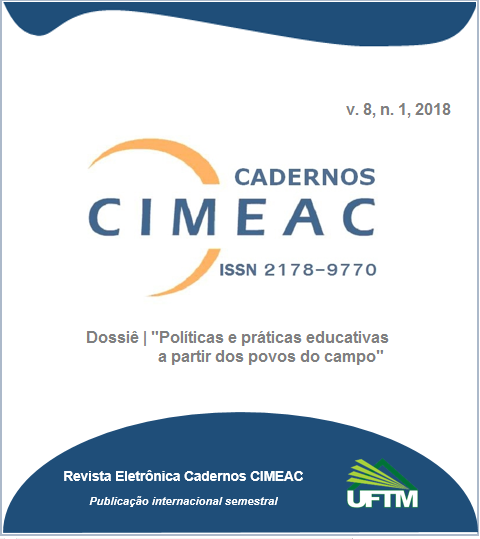Os Cadernos da Realidade dos alunos da LEDOC/UFES como agenciamentos coletivos de enunciação / The student's notebook on LEDOC/UFED as collective enunciation management
DOI:
https://doi.org/10.18554/cimeac.v8i1.2356Resumen
Este texto objetiva apresentar resultados de uma pesquisa que investiga os “usos” que os professores e os alunos fazem dos cadernos da realidade produzidos pelos alunos do curso de Licenciatura em Educação do Campo da Universidade Federal do Espírito Santo. Problematiza o modo como os usos desses cadernos expressam os currículos pensadospraticados. Utiliza, como aporte teórico-metodológico, o pensamento de Michel de Certeau (1994), Deleuze e Parnet (1977), Deleuze e Guattari (2015) e Lazaratto (2006; 2014). Aponta que os alunos fazem usos diversos dos cadernos: favorecer a memória, como indicam os textos que tratam desse instrumento; planejar suas ações; desabafar e fazer o pensamento movimentar, delirar, etc. Já os professores usam os cadernos para avaliar os processos de aprenderensinar e nos movimentos de invenções curriculares, pois acreditam que “uso” é poética, é invenção. Foi evidenciado ainda que os cadernos da realidade são agenciamentos maquínicos de desejo, ou seja, agenciamentos coletivos de enunciação que possibilitam movimentar o pensamento e abrir fissuras paradigmáticas. Afirma, assim, a necessidade de abrir/criar espaçostempos e redes de conversações para que professores e alunos possam dialogar sobre as escrileituras desses cadernos, a fim de ampliar e potencializar os processos inventivos dos currículos pensadospraticados na Educação do Campo.
Palavras-chave: Cadernos da Realidade; Pedagogia da Alternância; Currículos pensadospraticados; Educação do Campo.
ABSTRACT: This text aims to present results of a research that investigates the uses that teachers and students make of the notebook of reality poduced by the undergraduate students of the field of the Federal University of Espírito Santo. It problematizes the way in which the uses of these notebooks express the thoughtful curricula. It uses as a theoretical-methodological contribution the thought of Michel de Certeau (1994), Deleuze and Parnet (1977), Deleuze and Guattari (2015) and Lazaratto (2006, 2014). He points out that the students make different uses of the notebooks: to favor memory, as indicated in the texts that deal with this instrument; plan your actions; and to make the thinking move, delirious... The teachers use the notebooks to evaluate the learning processes and the movements of curricular inventions, because they believe that "use" is poetic, it is invention. It was also evidenced that the notebook of reality are machinic assemblages of desire, that is, collective assemblages of enunciation that make it possible to move thoughts and open paradigmatic fissures. It thus affirms the need to open /create spaces and networks of conversations so that teachers and students can talk about the writing of these notebooks, in order to broaden and enhance the inventive processes of the curricula considered in countryside education.
Keywords: Notebook of reality; Pedagogy of Alternation; Thoughtful curricula; Countryside education.
Descargas
Publicado
Número
Sección
Licencia
Os autores que publicam nesta revista concordam com os seguintes termos:
(a) Não cobramos dos autores para a publicação neste periódico.
(b) Autores mantém os direitos autorais e concedem à revista o direito de primeira publicação, com o trabalho simultaneamente licenciado sob a Licença Creative Commons que permite o compartilhamento do trabalho com reconhecimento da autoria e publicação inicial nesta revista.
(c) Autores têm permissão e são estimulados a difundir e a distribuir a versão publicada de seu trabalho online (ex.: em repositórios institucionais ou na sua página pessoal) após o processo editorial, já que isso pode aumentar o impacto e a citação do trabalho publicado (Veja O Efeito do Acesso Livre).
* * *
AUTHORS COPYRIGHT AND PUBLISHING RIGHTS
Authors who publish with this journal agree to the following terms:
(a) This journal does not charge authors for publication.
(b) Authors retain copyright and grant the journal right of first publication with the work simultaneously licensed under a Creative Commons Attribution License that allows others to share the work with an acknowledgement of the work's authorship and initial publication in this journal.
(c) For authors whose articles have been accepted: authors are permitted and encouraged to post their work online (e.g., in institutional repositories or on their website) after the publication of the text in Cadernos CIMEAC, as it can lead to productive exchanges as well as earlier and greater citation of published work (See The Effect of Open Access).

 10.18554/cimeac
10.18554/cimeac

